CocoSnap fidget clickers generate excessively loud noises for their small size. They are quite simple: a bunch of 3d-printed parts snapped together to capture magnets inside them. Some very smart people say you can’t make fidgets simpler than these. We came up with these, and hold pending patents on the concept of fidget walkers – think “walking a magnet with another magnet over a largely uneven surface”.
You can print these clickers for personal use. Feel free to build on them as well for non-commercial uses. They go under CC BY-NC-SA 4.0 as detailed on our main 3D-prints page. More on licensing later.
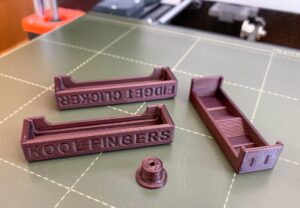
This package contains STL parts for 4 types of fidget clickers. Two of these clicker models are available on Amazon for those who can’t print, or can’t be bothered to get the right magnets. See later sections. Some parts are shared between clickers, namely the two half shells that enclose a “walking surface” with one of these properties: toggle switch, washboard, bumps and rails. There are also 3MF files for slicer apps we have used ourselves, which you may find useful.
Table of Contents
Download from these platforms
- https://www.thingiverse.com/thing:6244018
- https://www.printables.com/model/599619
- https://cults3d.com/:1485500
- https://makerworld.com/en/models/35835
Magnets required for clickers
Each clicker unit requires a disc magnet to be inserted into a control peg, and another magnet to be enclosed inside the clicker body. The disc magnet needs to be of specific dimensions to fit the small peg. Any magnet that fits the clicker body can be used as the inside magnet. The shape, the size and the magnetic strength of the inside magnet affect tactile and acoustic feedback.
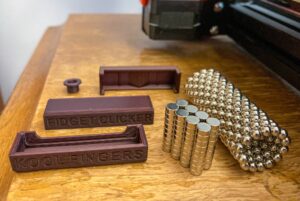
PEG MAGNET: a 6mm x 3mm N35 neodymium disc magnet. Most disc magnets found online actually measure 6mm x 2.67mm – these are usable too. Many disc magnets are sold without explicit specs for their strength. Most of these are N35.
INSIDE MAGNET: we recommend a 1/4″ (6.3mm) N52 neodymium ball magnet as the inside magnet. For most PLA prints, this produces a deep bass sound and a satisfactory haptic experience. But they are hard to come by, and are much more expensive than smaller and weaker ball magnets. The most common ball magnets are 5mm N35 magnets (the original Buckyballs) – these are fine and quite usable. But you will likely not find exact 5mm magnets. Many magnets sold under the “5mm-diameter” label are actually 3/6″ (4.76mm) ball magnets – they are even weaker. But if that’s all you’ve got, then use them. You can also substitute ball magnets with disc magnets, and even cube magnets, for different types of fidget walker feedback.
The clickers on our Amazon store are furnished with the 6mmx3mm N35 neodymium disc magnet and the 1/4″ N52 neodymium ball magnet we recommend. You can purchase these clickers at our Amazon store.
Warning: swallowed small magnets can stick together across intestines causing serious infections and death. Seek immediate medical attention if magnets are swallowed or inhaled.
Suggested print settings
Always go to our Kool Fingers website for the most up-to-date printing instructions. And remember that there are readme files next to 3MF files for common slicer apps. These clicker models have been designed with very specific fit tolerance, to make these pieces fit tightly but not too much that you can’t snap them together. Here are some general considerations:
* Print with PLA. But they also work with PETG, ABS, etc.
* They work best printed with 04mm nozzles
* Use a 0.15mm layer print profile
* Specifically, use a 0.2mm first layer height
* and the a 0.15mm height for all subsequent layers
* Top shell layers: 7
* Top shell thickness: 0.7 mm
* Bottom shell layers: 0.5
* Bottom shell thickness: 0.5 mm
* Detect thin walls: ON
* Sparse infill density: 30%
* Sparse infill pattern: Gyroid or Grid
Post-print processing
There is no need for post-print processing, except occasional cleaning of stray strings, and deburring of rugged edges and print defects.
However, the control peg should be carefully examined, to make sure that there are no surface irregularities, especially on the brim of a peg. The brim needs to slide freely within the slotted groove, when parts are snapped together.

The two half shells need to snap closed with no gaps between them. In order for this to happen, the “Walking Surface” part must not have visible “elephant’s foot”. Simply deburr the two long edges of a walking piece if needed.
Assembling a clicker
First, push a disc magnet into the control peg. Make sure the magnet sits flush. The peg needs to slide freely, so you don’t want to add unaccounted height to it with a partially-inserted magnet.
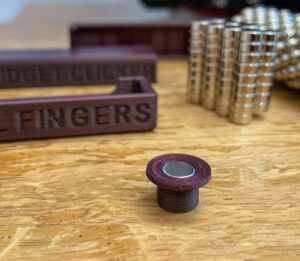
Take a ball magnet, and place it on the uneven surface of a “walking surface” part. Magnetically couple the ball magnet to the disc magnet which sits on the smooth surface of the “walking surface” part. This step is important, because we had often snap closed two half shells against a walking surface, only to realize that we forgot to put in the ball magnet, and/or the control peg. Trying to pry the shells open against internal latches without damaging gliding surfaces and edges may be close to impossible.
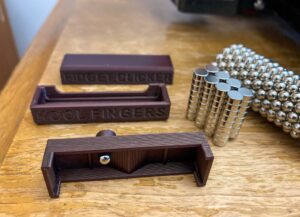
Snap the walking surface into one half shell. It doesn’t matter which shell you pick first. Just make sure that the peg is on the side of the half shell with a groove. The unfinished unit can be tested now. Slide the peg back and forth, and confirm that the peg glides smoothly.
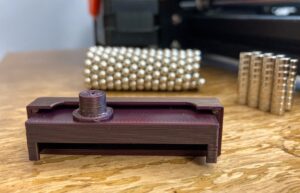
Enjoy the fidget walking experience, and confirm that the ball magnet moves well, before you snap the other half shell closed.
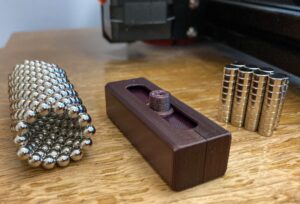
Licensing
We encourage you to tinker with clickers. Try coating the inside walking surface with nail polish or equivalent. You can even fill the inside with water and seal off the clicker. Tape the clicker to a sonorous surface such as a window pane or your bathroom door. Ot tape it to a tupperware container, or to your guitar. Try putting two control pegs into the groove. The possibilities are endless.
Fidget Walkers by Kool Fingers is licensed under Attribution-NonCommercial-ShareAlike 4.0 International. To view a copy of this license, visit http://creativecommons.org/licenses/by-nc-sa/4.0/.
Utility patent applications for fidget walkers and related concepts have been filed. Some are early-published and can be found at https://koolfingers.com/patents/. As already covered in our applications, these haptic fidgets are also applicable in a variety of fields including percussion instruments, underwater switches, magnetic locks, tabletop games, and even automated machineries.
Therefore, in addition to “CC BY-NC-SA 4.0”, all 3D models published here, their future derivations by third-parties, as well as non-derivative work are also covered by pre-issuance provisional rights, as long as the fidget walker concept applies. While you are free to create and print derivative designs, you must not commercialize them without our agreement.
Useful links
All our 3D-printable models
https://koolfingers.com/3d-prints/
Fidget walkers available on Amazon for purchase:
https://www.amazon.com/koolfingers
Up-to-date printing instructions for printing clickers:
https://koolfingers.com/3d-prints/printing-clickers/
YouTube videos:
https://www.youtube.com/@KoolFingersLLC
Patent applications:
https://koolfingers.com/patents/
KoolFingers.com 2023 CLK-v06
